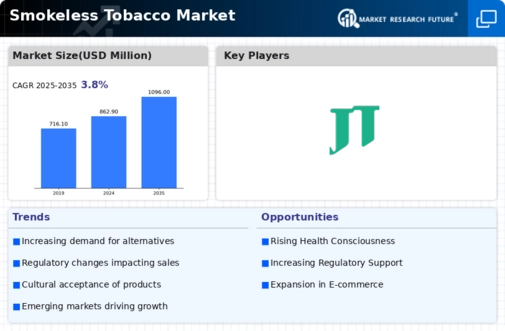Regulatory Changes
Regulatory frameworks surrounding tobacco products are evolving globally, impacting the Global Smokeless Tobacco Market Industry. Governments are implementing stricter regulations on traditional tobacco use, which may inadvertently promote smokeless alternatives as a less harmful option. For example, some countries have introduced policies that limit smoking in public spaces, thereby encouraging users to switch to smokeless products. This regulatory shift could contribute to the market's growth, with projections indicating a rise to 40 USD Billion by 2035. Such changes may compel companies to adapt their strategies to comply with new regulations while capitalizing on emerging opportunities.
Cultural Acceptance
Cultural factors significantly influence the Global Smokeless Tobacco Market Industry, as smokeless tobacco products are often more socially accepted in certain regions. In countries like India and Sweden, smokeless tobacco has deep-rooted cultural significance, contributing to its widespread use. This cultural acceptance can drive demand, as consumers are more likely to choose products that align with their social norms. The market's growth potential is evident, with estimates suggesting it could reach 40 USD Billion by 2035. Understanding regional preferences and cultural nuances may be essential for companies aiming to expand their market presence.
Rising Health Awareness
The Global Smokeless Tobacco Market Industry is experiencing a shift as consumers become increasingly aware of health risks associated with traditional tobacco products. This heightened awareness is driving demand for smokeless alternatives, which are perceived as less harmful. For instance, smokeless tobacco products often contain fewer carcinogens compared to cigarettes, appealing to health-conscious individuals. As a result, the market is projected to reach 25 USD Billion in 2024, reflecting a growing preference for products that align with healthier lifestyles. This trend suggests that manufacturers may need to innovate further to meet evolving consumer expectations.
Market Growth Projections
The Global Smokeless Tobacco Market Industry is poised for substantial growth, with projections indicating a market value of 25 USD Billion in 2024 and an anticipated increase to 40 USD Billion by 2035. This growth trajectory suggests a compound annual growth rate of 4.37% from 2025 to 2035, reflecting a robust demand for smokeless tobacco products. Factors such as rising health awareness, regulatory changes, and cultural acceptance are likely to drive this expansion. As the market evolves, stakeholders may need to adapt their strategies to capitalize on emerging opportunities and address potential challenges.
Innovation in Product Offerings
Innovation plays a crucial role in the Global Smokeless Tobacco Market Industry, as manufacturers continuously develop new products to attract consumers. The introduction of flavored smokeless tobacco products has gained traction, appealing to younger demographics seeking diverse experiences. Additionally, advancements in technology have led to the creation of more sophisticated delivery systems, enhancing user satisfaction. This focus on innovation is likely to drive market growth, with a projected compound annual growth rate of 4.37% from 2025 to 2035. As competition intensifies, companies may need to prioritize research and development to maintain relevance in a dynamic market.
Increased Availability and Accessibility
The Global Smokeless Tobacco Market Industry benefits from improved availability and accessibility of products, driven by the expansion of distribution channels. Retailers are increasingly stocking smokeless tobacco products, making them more accessible to consumers. Online sales platforms have also emerged, providing convenience for users seeking these products. This increased availability is likely to contribute to the market's growth, with projections indicating a rise to 25 USD Billion in 2024. As consumer preferences evolve, companies may need to enhance their distribution strategies to ensure that products are readily available to meet demand.


